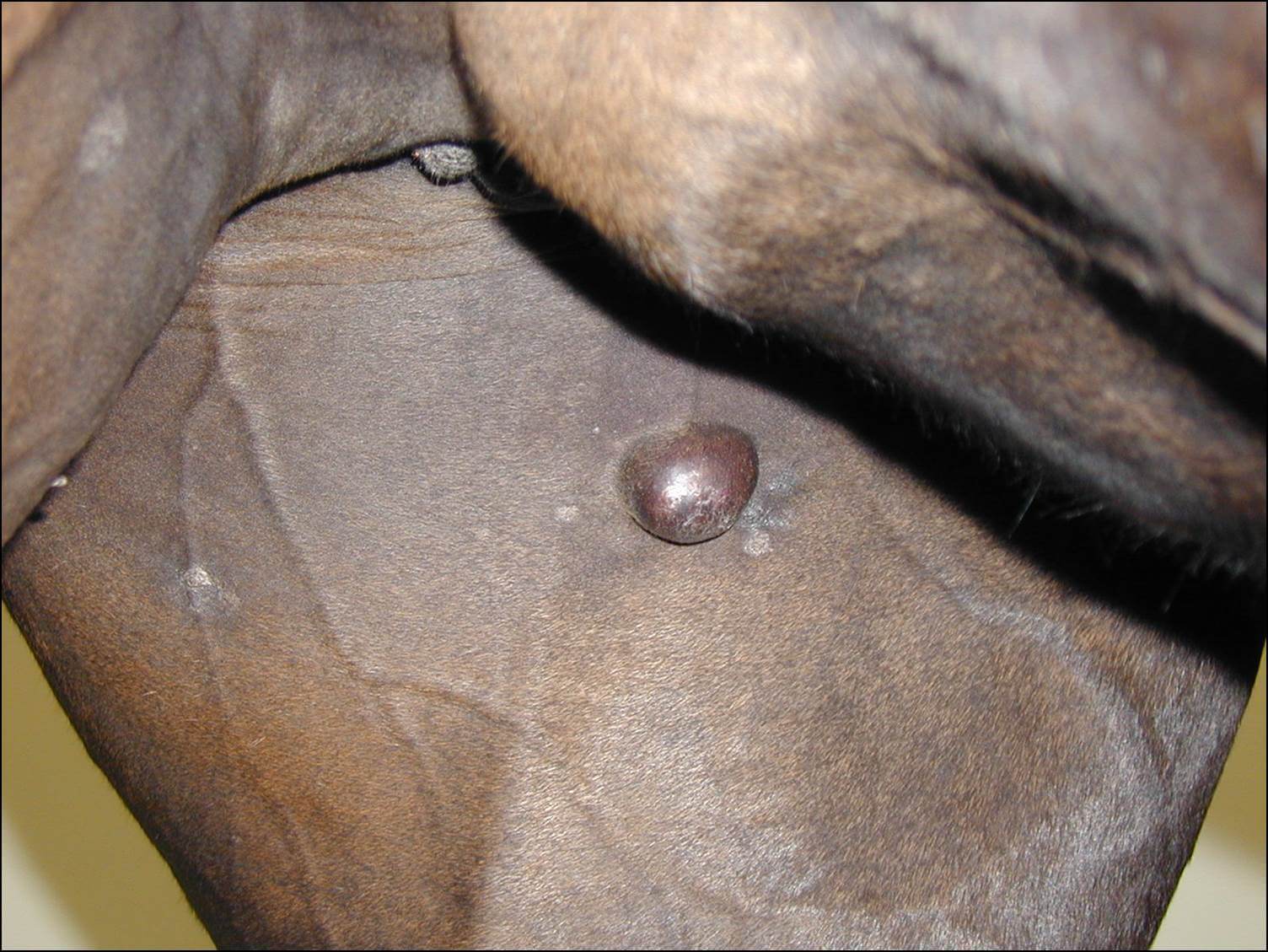Horses generally have a low rate of cancer. However, their most common type of cancer or tumour is a sarcoid which is a type of skin growth. Cancer sounds so serious, what does this mean? Cancer is a purposeless multiplication of cells which creates an abnormal mass or lump. It can be devastating because it can damage normal working parts of the body by squashing them, destroying them or altering their function. This all sounds very sinister, so we need to be sensible, lumps and growths should not be ignored. Simplistically small ones are easier to deal with then large ones. But now for some better news: equine sarcoids, unlike some other types of cancer, very rarely spread to other organs in the body, so it is also extremely rare for them to be life threatening. But they can be a major inconvenience and on occasion stop a horse from working.
There are many types of sarcoid and also other types of skin tumour too. Sometimes samples will need to be taken so that a lump can be identified, because different types of growth need different treatment. Some types of sarcoid your vet will be confident to identify just on its appearance and advise accordingly. Sarcoids are commonly found around the eyes, sheath, mammary glands, inner thighs and between the front legs. These are sites commonly frequented by flies. One of the commonest supported theories is that sarcoids are caused by a cattle wart virus (bovine papilloma virus) which is spread by flies. Research is ongoing to try and clarify this virus theory.
Types of Sarcoid
Sarcoids are classified as six types:
Occult sarcoid – flat areas often found on the face, sheath or inner thighs. These often start as hairless or de-pigmented (pale) areas mimicking ring worm or tack rubs. They can thicken and may become crusty or bleed. They are subtle lesions and can be difficult to spot.
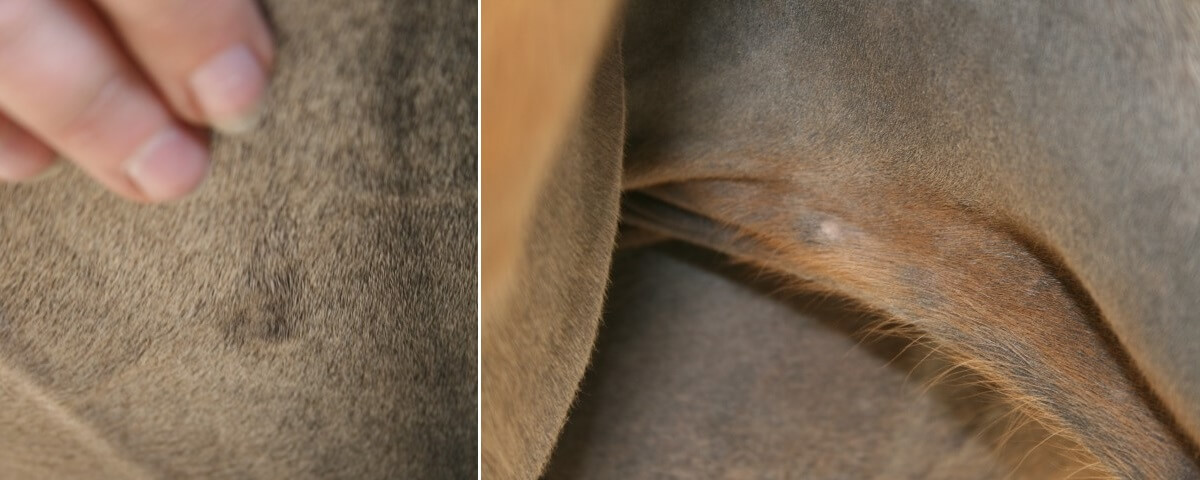
Occult sarcoids – inner thigh(L) and sheath(R)
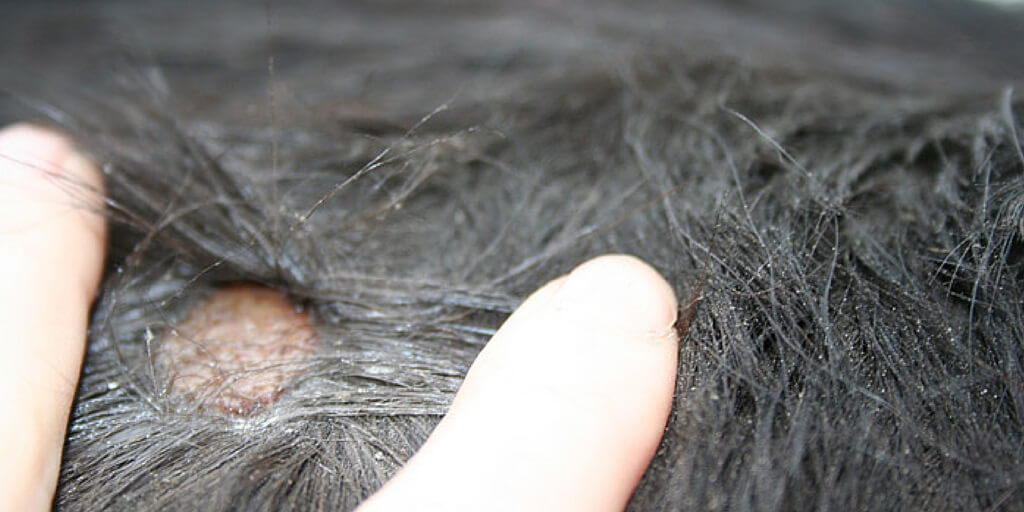
Ringworm
Verrucous sarcoid – flat areas of wart-like appearance often found on the ventral abdomen (under the belly), face, sheath or groin. They are often grey in colour and may look warty or flaky. Can become more aggressive if interfered with. Single or multiple.
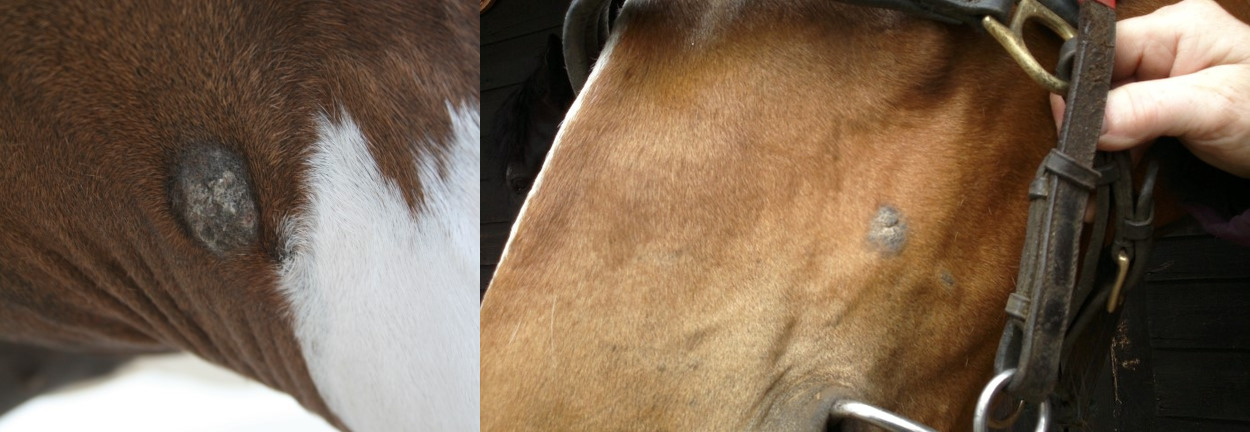
Verrucous sarcoids – under the elbow(L) and on the face(R)
Nodular sarcoid – raised and firm spherical lumps usually covered by normal skin. Often found between front or back legs, on the ears or sheath and may be single or multiple. These can frequently be lifted clear of underlying structures. They can turn into fibroblastic sarcoids if traumatised.
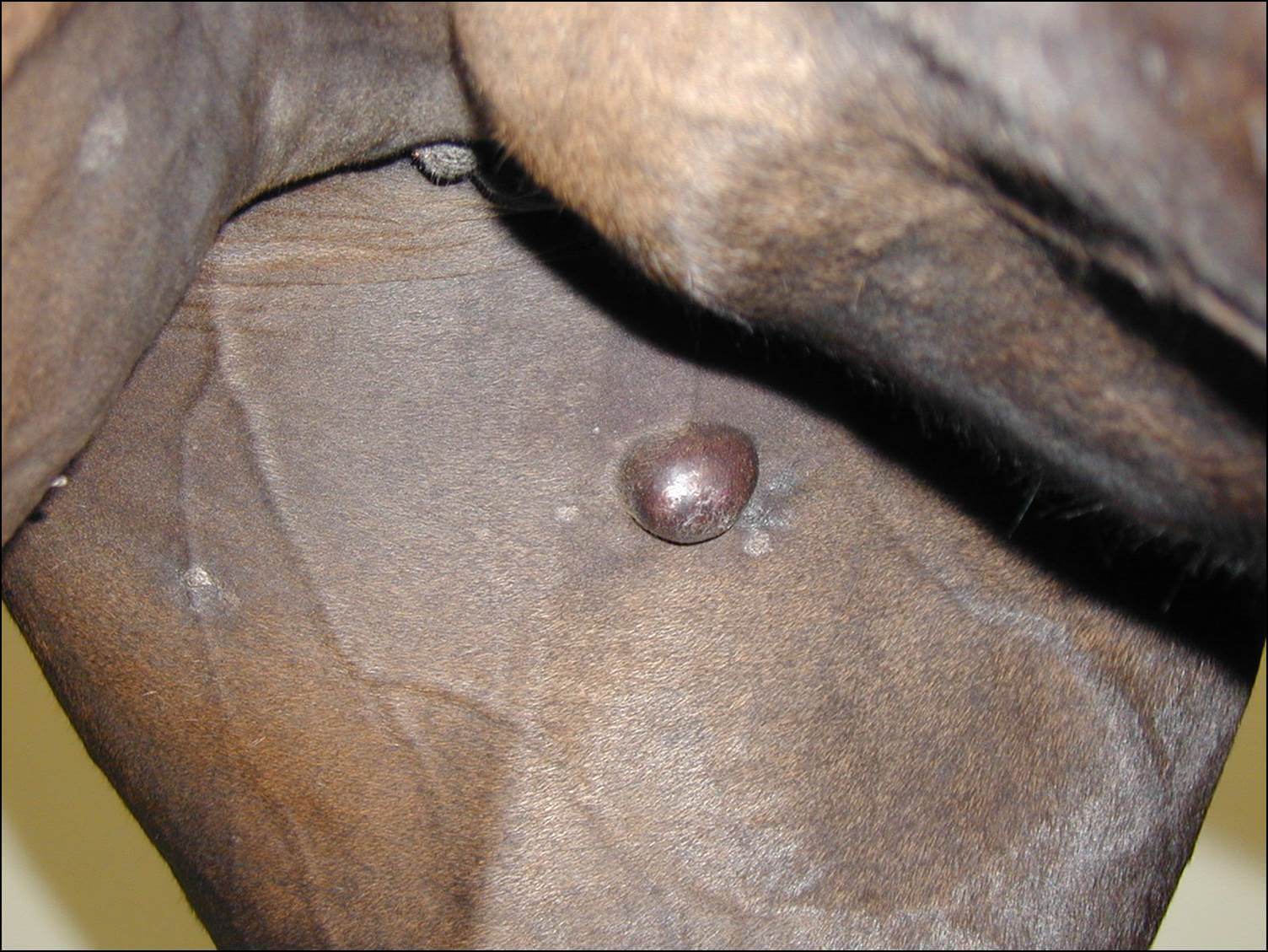
Nodular sarcoid
Fibroblastic Sarcoid – have fleshy, ulcerated appearance so bleed easily. May occur at the site of wounds as well as on the face and legs. They can look like an ulcerated “bunch of grapes”. These often enlarge at speed.
Mixed Sarcoids – An individual horse may have just one type of sarcoid, whilst another horse may have a mixture of several types. They are commoner in geldings than mares and most cases are initially seen in horses aged 3-6years.
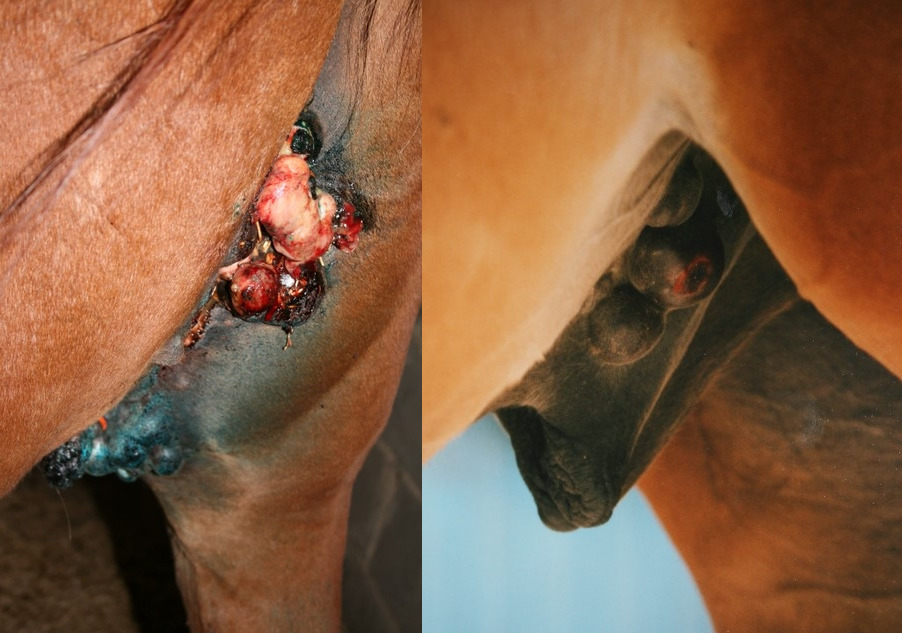
Left: Multiple ulcerated sarcoids between the hind legs. Right: nodular sarcoids and an ulcerating fibroblastic sarcoid on the sheath. Note also an occult sarcoid on the inner thigh
Malevolent/malignant Sarcoid – aggressive – may spread along the path of veins or lymph vessels. May appear as cords of tumours. Malevolent sarcoids are the most aggressive type. They rapidly spread over large areas and appear as a mixture of nodules, warts and ulcerated areas, often large bundles. Sometimes these can be so severe they are untreatable, fortunately they are rare.
So if sarcoids are not life threatening why treat them?
There are many reasons:
- to prevent deformities and the disruption of the function of important structures, e.g., sarcoids around the eyes can cause eyelid deformities which interfere with eyelid function and tear distribution. Rarely the resulting irregularity of the eyelid can cause corneal ulceration.
- to prevent interference with tack e.g. girth, martingale or bridle, which would lead to discomfort or bleeding.
- to stop the spread of sarcoids on this horse
- to also stop the spread of sarcoids to companion horses via flies,
- to prevent the discomfort of the tumours e.g. between the hind legs,
- to reduce fly annoyance by removing the bleeding sarcoid – some of which can become infected and unhygienic
- to improve the appearance of the horse
Treatment
Sarcoids can mimic more sinister tumours and vice versa, so biopsy (taking an actual sample of the mass and sending to the laboratory for analysis) may be necessary.
Also, sarcoids can mimic sweet itch, ringworm, traumatised and thickened skin and vice versa. With such a large range of different appearances of actual sarcoids (and other skin diseases) it is not surprising that a huge range of treatments has also emerged. No single treatment is 100% effective. Ask your vet for the best advice on an individual case, please don’t dabble with treatments as this often just delays an effective treatment and may actually make the condition worse eventually costing more money to treat. Often the location and type of sarcoid will dictate the best treatment.
Wilful neglect. Sometimes a vet may advise just to monitor a single occult or nodular sarcoid. If the sarcoid changes or enlarges further veterinary advice should be sought. Rarely an isolated sarcoid may shrivel/fall off presumably due to the horse’s own immune system ‘rejecting’ the tumour.
Nodular sarcoids, which can be lifted clear of underlying tissues, can often be simply treated by ligation with a rubber ring. This can be very successful as the sarcoid is starved of a blood supply, withers and dies.
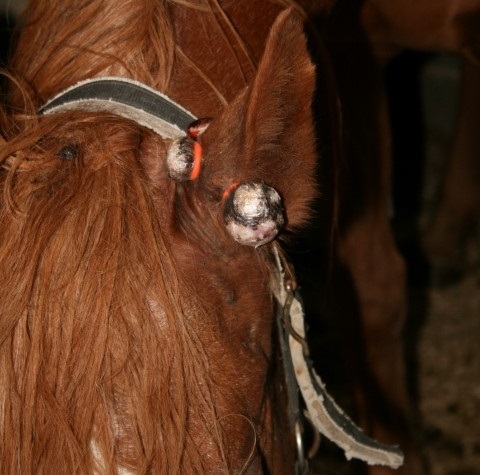
Ringed nodular sarcoid
Many creams have been used and a full discussion is too large for this article. However, Liverpool Cream is probably the most frequently used, this cytotoxic (cell killing) treatment has been very successful but needs multiple applications by a vet. It is dangerous and will damage normal skin on you or your horse, so great care is required. Horses tolerate its application better if pain relief is provided before the area swells and becomes sore.
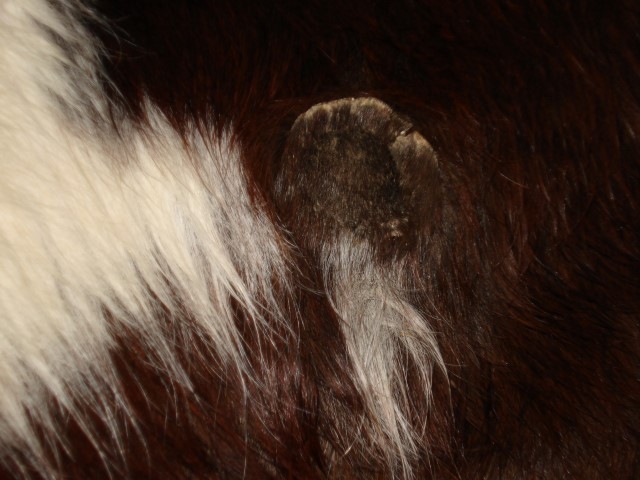
Occult sarcoid shrivelling after a course of Liverpool cream, the plaque of dead tissue will drop away to leave a small scar

Sarcoid pre-treatment, during treatment, and after treatment
Cryosurgery – involves cycles of freezing and thawing tissue to destroy it. It can be effective on small lesions, but recurrence rate seems to be high after this treatment.
BCG injection (BCG is a human vaccine for tuberculosis) – this can be injected into nodular lesions on the face every week for three treatments. Horses must be monitored for an hour after treatment for an allergic reaction so it is time consuming but very effective for facial nodular and fibroblastic sarcoids. It should not be used on lesions elsewhere on the body. Good cosmetic results.
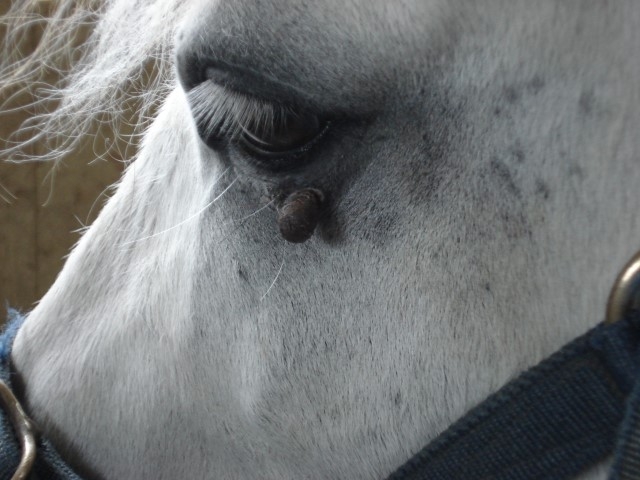
Pony during BCG treatment, this resulted in no scar
Other forms of chemotherapy, radio therapy and traditional surgery have all been tried with varying success.
Currently surgical laser removal of sarcoids is becoming popular and backed up with scientific evidence. The laser cuts and burns tissue providing a margin of dead tissue around the sarcoid as it is removed. This leaves a large area which heals slowly with scarring. In a recent research paper, 82% of sarcoids removed by laser did not recur
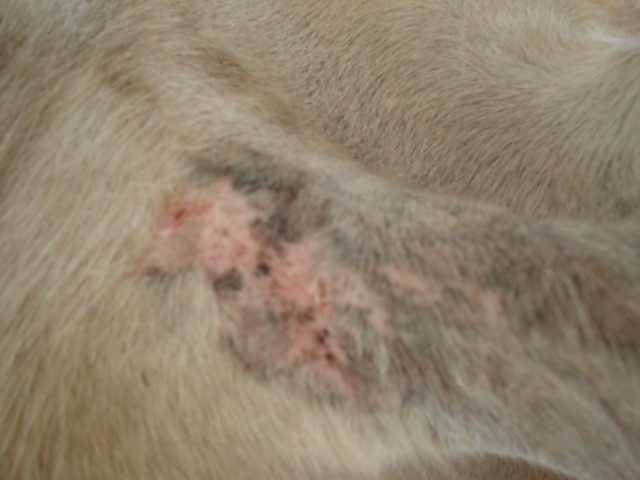
Post treatment scarring
Remember
Small lesions are easier to treat than larges ones. Extensive lesions will need more aggressive treatments. Not all treatments are successful; recurrence is common. Trauma to a sarcoid will aggravate it, this may be surgery or cream application, so a treatment plan is required. All horses can suffer sarcoids, even donkeys and zebra.
No two sarcoids are the same so an individual treatment plan and monitoring is required. Sarcoids can be frustrating to treat. Many horses have a mixture of types, often in different locations. Every sarcoid should be assessed by your vet and monitored/treated as advised.
